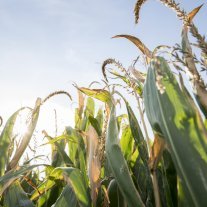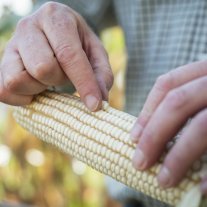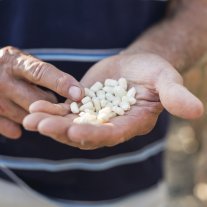Corn is a popular starchy vegetable that is widely consumed in the US, particularly in the summer. When turned into a flour, corn makes an ideal substitute for wheat in gluten-free breads, pastas, and baked goods. Corn is rich in potassium, magnesium, and B-vitamins, which are critical for individuals following a gluten-free diet that may be lacking in these nutrients.
Description
Corn (Zea mays) belongs to the family of sweet grasses (Poaceae). Approximately 300 varieties exist worldwide. Corn can be considered a grain or a vegetable depending on when and how it is harvested. Fully mature corn that is dry when harvested can be milled into cornmeal and used like a grain (e.g. used to make bread, tortillas, etc.). Popcorn is another example of a whole grain form of corn. On the other hand, fresh corn (e.g. corn on the cob, frozen corn, canned corn) is considered a starchy vegetable.

Where is corn grown?
Corn is thought to be native to Mexico. History shoes that corn has been staple in Native American diets from as far back as 3,000 B.C. According to the United Nations Food and Agriculture Organization (FAO), around 1.15 billion tons of corn on 194 million hectares were harvested worldwide in 2018. The United States and China are the largest corn producers in the world.
Structure of the plant
Corn is an annual plant with a single stem that carries the male inflorescence, the so-called flag, on the top of the stem, while the female inflorescence is an ear that leads to the armpit of the leaves. The leaves are alternate on the stem. It has very superficial, far-reaching roots, and depending on the variety, may grow as tall as 10-20 feet. The corn kernel is a non-opening fruit (caryopsis) that is enclosed in the pericarp and consists of an embryo, endosperm and aleuron.



Sowing & Harvesting Information
Corn is a summer crop that is planted around mid-April or May when the soil starts to get warm (45-50° F). Very precise irrigation techniques are used during the cultivation because the crop requires damp soil. From the time of pollination, there are various stages of growth and ripening:
- Milky ripening: about 25-30 days after flowering; stage of starch development
- Waxy maturation: about 45-50 days after flowering
- Physiological ripening: about 60-70 days after flowering; phase that stops additional starch accumulation
The harvest can begin as soon as the threads of the flowers turn brown or black. The yield is varies greatly.

Macronutrients
Carbohydrates
One hundred grams of corn contains about of 64 g of carbohydrates. Corn is very nutrient dense and has a high natural sugar content right after harvesting, which gives it a sweet taste. Longer harvesting leads to more sugar conversion to starch, leading to a less sweet corn product. The glycemic index of corn is around 70, which is very similar to wheat.
Dietary fiber
On average, there is about 10g of fiber per 100g of corn. This is largely in the form of insoluble fiber.
Protein
The protein content of corn is about 8g per 100g of corn. The protein contained in corn has a biological value of 72%. Protein in wheat, on the other hand, only has a biological value of 59%.
Fat
About 87% of the fat in corn is unsaturated, with linoleic and oleic acid making up most of the fatty acid content. The primary saturated fatty acid is coming from palmitic acid.
Micronutrients
Vitamins
Corn is a source of B-vitamins. In particular, it is high in niacin, which is responsible for macronutrient metabolism. Corn also contains potassium, which plays an important role in cell electrolyte balance and nerve and muscle function.
Antioxidants
Corn is rich in vitamin E, which has an antioxidant effect, protecting cells from free radicals.
Nutrition Table

References
Nuss (2010). Maize: A Paramount Staple Crop in the Context of Global Nutrition. Comprehensive reviews in food science and food safety. 417-436 https://doi.org/10.1111/j.1541-4337.2010.00117.x
D. Panzeri, V. Cesari, I. Toschi & R. Pilu (2011) Seed Calorific Value in Different Maize Genotypes, Energy Sources, Part A: Recovery, Utilization, and Environmental Effects, 33:18, 1700-1705, DOI: 10.1080/15567030903452118
http://www.ernaehrung.de/lexikon/ernaehrung/b/Biologische-Wertigkeit.php
Food Composition and Nutrition Tables
https://fddb.mobi/de/naturprodukt_mais_roh.html,
https://www.pflanzenforschung.de/de/pflanzenwissen/pflanzensteckbriefe/mais


